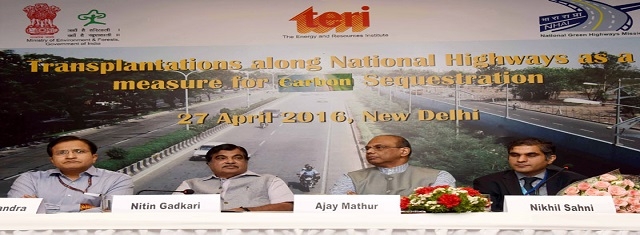News
Greening Highways Will Immensely Benefit The Rural Economy
Nitin Gadkari

Inaugural meet of the project (Source: PIB/GR/TYP/BIN/USPA/WN/IAIJ)
USPA NEWS -
The Union Minister for Road Transport & Highways and Shipping, Mr. Nitin Gadkari at the inaugural session of the Transplantations along National Highways as a measure for Carbon Sequestration, in New Delhi on April 27, 2016.
Projects Will Be Monitored Through Satellite Technology
Projects Will Be Monitored Through Satellite Technology
The Minister of Road Transport and Highways and Shipping Mr. Nitin Gadkari inaugurated a workshop on Transplantation Along National Highways in New Delhi on April 27. In his inaugural address, he said, “Roadsmust be viewed as green highway opportunities. Aside from the environmental and aesthetic aspects, they have a huge potential to generate jobs and thus benefit the rural economy. It may even be linked with the NREGA scheme.“
He also invited interested investors to take up experimental projects and said, “If needed, we will provide technology and financial support as well to the selected agency. As an incentive three winners from each state every year will also be awarded for exemplary work.“ Projects will be monitored through satellite technology with payments to be made only after the success of projects. He urged research institutes like TERI to share its inputs on the transplantation techniques. The Minister also suggested that NHAI could utilize material like sand and soil by digging in areas along the highway and the villages would benefit as this would create the much needed ponds and lakes for rural economies.
Talking about environmental benefits that accrue from greening highways, the Minister urged the use of biofuels in machines to be employed in the project and organic fertilizers for transplanted trees.
Mr. Raghav Chandra, Chairman, NHAI said, “We have set aside 1 per cent of our project cost for transplantation, plantation, beautification and maintenance. We have adequate funds and we intend to use it for setting SOPs, build capacity and imbibe the best global practices.“
Mr. Raghav Chandra, Chairman, NHAI said, “We have set aside 1 per cent of our project cost for transplantation, plantation, beautification and maintenance. We have adequate funds and we intend to use it for setting SOPs, build capacity and imbibe the best global practices.“
Doruvu Paul Jagan Babu New Delhi India Ministry Of Transportation Nitin Gadkari Greenary National Highways Nrega
Liability for this article lies with the author, who also holds the copyright. Editorial content from USPA may be quoted on other websites as long as the quote comprises no more than 5% of the entire text, is marked as such and the source is named (via hyperlink).





